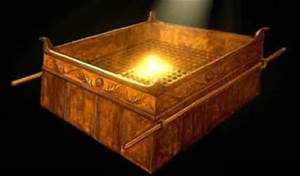Today we begin Exodus Chapter 27.
For the Complete Jewish Bible, click here.
For the King James version, click here.
We’ve spent the last couple of days talking about the Tabernacle’s tent sanctuary which housed both the Holy Place and the Holy of Holies.
From today, we’re going to move to the outer courtyard (the third zone of holiness) and focus on what is termed the “Brazen Altar”.
Depending on which Bible translation you’re reading, this object has also been called the “Altar of Sacrifice”, “Altar of Burnt Offering”, or just “Bronze Altar”.
All of these terms are referring to the same thing.
The most important thing you need to understand is that while the Ark of the Covenant was the holiest object INSIDE the tent sanctuary, the Brazen Altar was the holiest object OUTSIDE of it.
This is where countless millions of innocent animals would have their blood spilled and their bodies burnt to ashes to atone for the sins of Israel.
In Hebrew, the “Brazen Altar” is MIZBA HA-‘OLAH.
Brazen or bronze was a mixture of iron and copper and was the hardest metal they had to work with in those times.
The Altar was basically a fire pit.
It was a box that stood a little under five feet high and was about 7.5 feet in length on each side.
Its frame was made out of Acacia wood and layered with Bronze to keep it from succumbing to incineration.
Four bronze horns were molded into it, one on each top corner of the altar.
These horns were used to keep the sacrificial animals tied down.
Archeological investigation has established that “horned” altars were actually quite common in the West Semitic world.
When some altars of the Canaanites were dug up, it was found that these had horns on them as well.
There were several tools and implements that were required to be used with the Brazen Altar: shovels to clean up the burnt up ashes, censors (fire pans) to carry the hot coals, and pails and buckets used to catch the animal blood being spilled.
All of these items were also fashioned out of bronze (remember we’re in the third zone of holiness).
What was similar about the Ark of the Covenant and the Brazen Altar is that they both had rings attached to their sides so that wooden poles could be inserted through the rings for easy transport.
However, unlike the Ark, the Altar was NOT transported via wagon, but was instead carried by hand from location to location.
What’s interesting about the location of the Brazen Altar is that we can see a direct connection to the Altar that was erected at Mount Sinai to seal the covenant between Israel and HASHEM.
Recall that the Tabernacle’s three zones of holiness can also be seen at Sinai.
If you want to review this teaching, click here.
Just as the Brazen Altar was placed right inside the gate of the Outer Court, at Sinai God also had Moses place an Altar outside of the Holy Area on the valley floor of Mount Sinai beyond the fence barrier separating the common people from the elders or representatives of Israel.
So, true to this pattern, the Brazen Altar was placed OUTSIDE the holy area of the Tabernacle sanctuary in the Outer Court where the common folk had access to it.
The location of the Brazen Altar being between the Outer Court gate and the entrance to the Holy Place has much spiritual and prophetic significance.
This means that one had no choice but to pass by the Altar to get to the sanctuary.
Before the priest could enter the tent sanctuary, without exception he had to make a sacrifice on the Brazen Altar.
I believe this is prophetic and foreshadows the sacrifice of Yeshua.
Let me take it a step further.
I would hasten to say that probably the best symbol we can used to help us understand the connection between the Brazen Altar and Yeshua would be the cross.
Just as the sacrificial animals had to be raised up to the Altar, bound to it, and have their blood spilled to atone for Israel’s sins, so too did Yeshua have Himself bound and then nailed to a cross where His blood was also spilled for Israel’s sins.




Where in Scripture does it say that the sacrifices were bound or tied to brazen altar? They were slaughtered before putting on the altar. I hope you can help me as I’ve “heard” it taught, but no scripture references. Thank you!